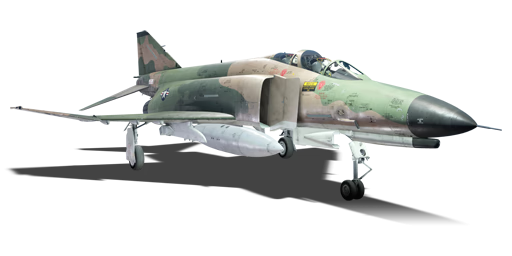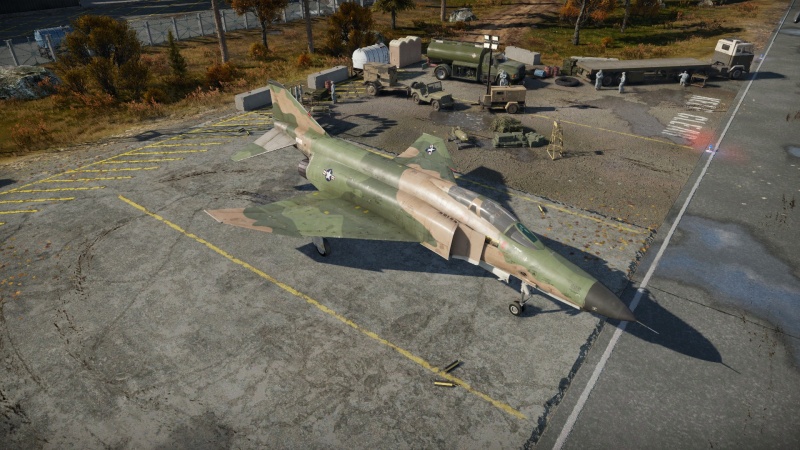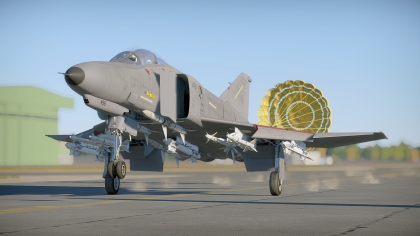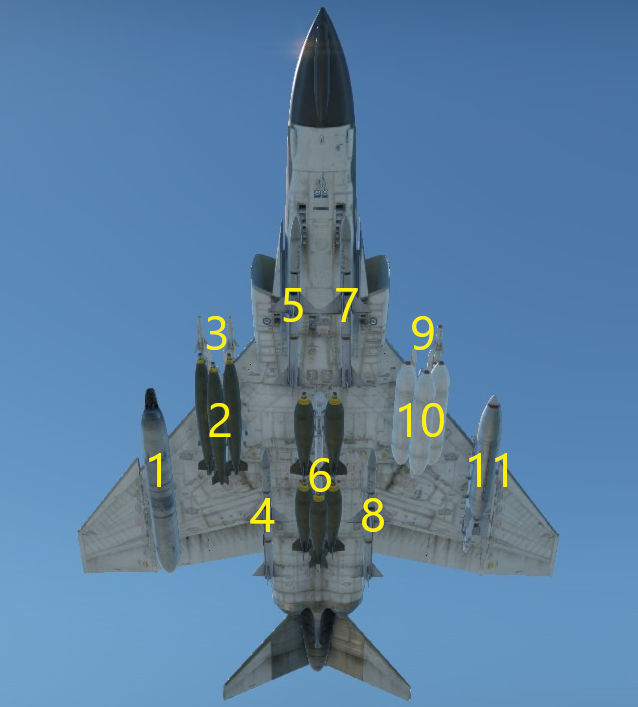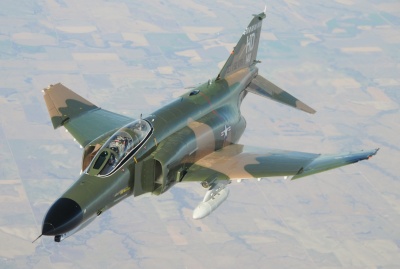F-4E Phantom II
| This page is about the American jet fighter F-4E Phantom II. For other versions, see F-4 Phantom II (Family). |
Contents
Description
The F-4E Phantom II is a rank VII American jet fighter with a battle rating of 11.3 (AB/RB) and 10.7 (SB). It was introduced in Update 1.97 "Viking Fury".
The mighty F-4E Phantom II is a famous US aircraft from the Vietnam War era and a reliable workhorse of many militaries around the world. Powered by two General Electric J79-GE-17 jets, each producing an incredible 8,010 kgf on maximum afterburner, the F-4E boasts high speed and a solid climb rate. Leading-edge "Agile Eagle" slats increase its turning capability and somewhat mitigate the reputation of the Phantom family as flying bricks. In the weapons department, the F-4E has access to AIM-7E-2 Sparrows for medium-to-long range combat, AIM-9J Sidewinders for close-in work, and an enormous array of ground attack ordnance including AGM-65 Maverick air-to-ground missiles and AGM-62 Walleye glide bombs. This multi-role vehicle is a supremely capable ground attacker and a competitive fighter, though in air combat pilots must account for its lack of a pulse-Doppler radar.
General info
Flight performance
| Characteristics | Max Speed (km/h at 12,192 m) |
Max altitude (metres) |
Turn time (seconds) |
Rate of climb (metres/second) |
Take-off run (metres) | |||
|---|---|---|---|---|---|---|---|---|
| AB | RB | AB | RB | AB | RB | |||
| Stock | 2,097 | 2,074 | 16000 | 26.5 | 27.5 | 160.8 | 151.2 | 850 |
| Upgraded | 2,202 | 2,140 | 25.5 | 26.0 | 221.6 | 190.0 | ||
Details
| Features | |||||
|---|---|---|---|---|---|
| Combat flaps | Take-off flaps | Landing flaps | Air brakes | Arrestor gear | Drogue chute |
| ✓ | ✓ | ✓ | ✓ | ✓ | ✓ |
| Limits | ||||||
|---|---|---|---|---|---|---|
| Wings (km/h) | Gear (km/h) | Flaps (km/h) | Max Static G | |||
| Combat | Take-off | Landing | + | - | ||
| 1458 | 463 | 607 | 584 | 463 | ~11 | ~4 |
| Optimal velocities (km/h) | |||
|---|---|---|---|
| Ailerons | Rudder | Elevators | Radiator |
| < 810 | < 750 | < 700 | N/A |
Engine performance
| Engine | Aircraft mass | |||||
|---|---|---|---|---|---|---|
| Engine name | Number | Basic mass | Wing loading (full fuel) | |||
| General Electric J79-GE-17 | 2 | 14,205 kg | 408 kg/m2 | |||
| Engine characteristics | Mass with fuel (no weapons load) | Max Takeoff Weight | ||||
| Weight (each) | Type | 9m fuel | 20m fuel | 30m fuel | ||
| 1,750 kg | Afterburning axial-flow turbojet | 15,964 kg | 18,027 kg | 20,069 kg | 24,000 kg | |
| Maximum engine thrust @ 0 m (RB/SB) | Thrust to weight ratio @ 0 m (WEP) | |||||
| Condition | 100% | WEP | 9m fuel | 20m fuel | 30m fuel | MTOW |
| Stationary | 5,200 kgf | 8,010 kgf | 1.00 | 0.89 | 0.80 | 0.67 |
| Optimal | 5,200 kgf (0 km/h) |
10,170 kgf (1,400 km/h) |
1.27 | 1.13 | 1.01 | 0.85 |
Survivability and armour
The survivability features of the F-4E Phantom II have grown compared to its predecessor with an armour plate and missile countermeasures attached.
By this stage in the high-rank battles, all the fuel tanks are self-sealing. While this will assist with any fuel tank punctures from machine gun calibre weapons, the presence of fast-firing autocannons and missiles mean that these self-sealing tanks are only an accessory to the overall survival of the aircraft.
The addition of an armour plate is a minor benefit as it is only an 8.5 mm steel plate just below the forward fuel tank in the fuselage. This is only thick enough to block a glancing shot to the fuselage. Its most effective use seems to when the F-4E Phantom II as it is pulling up from an attack run, as it is in that angle where the armour plate can potentially block any shot threatening the fuselage fuel tanks and engine. However, considering the small size it is made up of and the large plane overall, this armour plate should not be relied upon for the overall survival of the aircraft.
The biggest change from previous version is the countermeasure flares, which are greatly useful at deterring incoming infrared-homing missiles like the Sidewinders or R-60s. To utilise the flares, one must turn off their engine afterburners to eliminate that as a significant source of heat, deploy the flares in a suitable manner, then bank away from the flares to that the missile lock onto the remaining heat source rather than the plane's engine.
A survivability feature shared with its predecessor is the Radar Warning Receiver (RWR). The RWR will ping the player in the source of any incoming radar scans, and will also notify if the radar source have achieved a lock-on with the player. Keep an eye on this as it may signify to the player that an enemy semi-active radar homing missile may be launched soon and evasive actions should be taken.
Modifications and economy
Armaments
| Ballistic Computer | |||
|---|---|---|---|
| CCIP (Guns) | CCIP (Rockets) | CCIP (Bombs) | CCRP (Bombs) |
| |
|
|
|
Offensive armament
The F-4E Phantom II is armed with:
- A choice between two presets:
- 1 x 20 mm M61A1 cannon, chin-mounted (640 rpg)
- 1 x 20 mm M61A1 cannon + 90 x countermeasures
Due to this cannon's high rate of fire, trigger discipline is a must.
Suspended armament
The F-4E Phantom II can be outfitted with the following ordnance presets:
- Without load
- 2 x AIM-9E Sidewinder missiles
- 3 x 20 mm GAU-4 cannons (1,200 rpg = 3,600 total)
- 24 x 250 lb LDGP Mk 81 bombs (6,000 lb total)
- 24 x 500 lb LDGP Mk 82 bombs (12,000 lb total)
- 19 x 750 lb M117 cone 45 bombs (14,250 lb total)
- 13 x 1,000 lb LDGP Mk 83 bombs (13,000 lb total)
- 3 x 2,000 lb LDGP Mk 84 bombs (6,000 lb total)
- 4 x BLU-27/B incendiary bombs
- 285 x FFAR Mighty Mouse rockets
- 60 x Zuni Mk32 Mod 0 ATAP rockets
- 4 x AIM-9E Sidewinder missiles
- 4 x AIM-9J Sidewinder missiles
- 4 x AIM-7E Sparrow missiles
- 4 x AIM-7E-2 Sparrow missiles
- 2 x AGM-12C Bullpup missiles
- 6 x AGM-65B missiles
- 4 x 505 kg AGM-62A Walleye I bombs (2,020 kg total)
- 4 x 2,000 lb GBU-8 bombs (8,000 lb total)
- 2 x 2,000 lb GBU-15(V)1/B bombs (4,000 lb total)
Custom loadout options
| 1 | 2 | 3 | 4 | 5 | 6 | 7 | 8 | 9 | 10 | 11 | ||
|---|---|---|---|---|---|---|---|---|---|---|---|---|
| 20 mm GAU-4 cannons (1200 rpg) | 1 | 1 | 1 | |||||||||
| 250 lb LDGP Mk 81 bombs | 6 | 3 | 6 | 3 | 6 | |||||||
| 500 lb LDGP Mk 82 bombs | 6 | 3 | 6 | 3 | 6 | |||||||
| 750 lb M117 cone 45 bombs | 4 | 3 | 5 | 3 | 4 | |||||||
| 1,000 lb LDGP Mk 83 bombs | 2 | 3 | 3 | 3 | 2 | |||||||
| 505 kg AGM-62A Walleye I bombs | 1 | 1* | 1* | 1 | ||||||||
| 2,000 lb GBU-8 bombs | 1 | 1* | 1* | 1 | ||||||||
| 2,000 lb GBU-15(V)1/B bombs | 1* | 1* | ||||||||||
| 2,000 lb LDGP Mk 84 bombs | 1 | 1 | 1 | |||||||||
| BLU-27/B incendiary bombs | 1 | 2 | 1 | |||||||||
| FFAR Mighty Mouse rockets | 57 | 57 | 57 | 57 | 57 | |||||||
| Zuni Mk32 Mod 0 ATAP rockets | 12 | 12 | 12 | 12 | 12 | |||||||
| AGM-12C Bullpup missiles | 1* | 1* | ||||||||||
| AGM-65B missiles | 3* | 3* | ||||||||||
| AIM-7E Sparrow missiles | 1 | 1 | 1 | 1 | ||||||||
| AIM-7E-2 Sparrow missiles | 1 | 1 | 1 | 1 | ||||||||
| AIM-9E Sidewinder missiles | 1, 2* | 1, 2* | ||||||||||
| AIM-9J Sidewinder missiles | 2* | 2* | ||||||||||
| Maximum permissible weight imbalance: 1,500 kg | ||||||||||||
| * Marked options for hardpoints 2/10 cannot be used in conjunction with air-to-air missiles on hardpoints 3/9 respectively | ||||||||||||
Usage in battles
The F-4E Phantom II is well-suited for any in-game situation. For attacking ground targets, the plane is armed with an assortment of bombs and rockets, and against air targets, players may employ the vehicle's deadly air-to-air missiles and frontal cannon. If desired, three externally-mounted gunpods may be equipped, but note that these may not be useful in certain situations. Although they will undoubtedly increase the vehicle's destructive capabilities, they also appreciably hinder flight performance through induced drag. In many situations, one front-facing cannon is all that is required to dispatch an opponent aircraft. As for the missiles, the ones used by this plane are average at its tier, comparable to the R-60 missiles equipped by the MiG-21MF (Germany) and the MiG-21SMT (albeit with worse maneuverability). The AIM-9J missiles are most effective when fired from between 1 to 3 km away from the target. Any closer and they will struggle to track and likely veer off target for a miss.
The F-4E has one of the highest rates of climb out of any vehicle in the game. This is however where most of its performance advantages end. Due to its weight, the Phantom has rather mediocre acceleration, and not the best top speed. It is not advised to dogfight anything other than Starfighters and other Phantom variants, as the F-4 has a very poor turn rate. Although the aircraft has better energy retention than most of its opponents, it still bleeds considerable amounts of speed while turning, which can't be regained very quickly due to the aircraft's heavy weight. It also performs quite poorly at low speeds, which is also caused by its weight.
In air realistic battles, it is recommended to take a balanced fuel load of 20 or 30 minutes, depending on how aggressive you fly (this will also allow you to liberally use the afterburner without fear of premature fuel exhaustion). The most useful Air RB armament for the F-4E are the 4 AIM-9Js or 4 AIM-7E-2s although due to its lackluster dogfighting ability the Sparrows are almost always the better choice. The best strategy is to accelerate to a speed of roughly 900-1100km/h on the deck and then zoom climb to altitude (5km or higher), where the pilot should accelerate to the highest speed possible. Lock on to targets with your radar and use your Sparrows to shoot down enemy aircraft when in range; and remember to keep an eye on your RWR as being at altitude makes you an easy target for the long range missiles prevalent at this tier. Sparrows should ideally be launched above Mach 1 to take maximum advantage of their range and manoeuvrability. After using up all your Sparrows, return to base to rearm. It is important to note that because of its poor flight characteristics, the Phantom will struggle in one-on-one fights, making it vital to keep your teammates around and to avoid dogfighting whenever possible. The Phantom should target enemies turnfighting its friendlies, as not only the enemy may be distracted and slow, but it provides you a chance to save your teammate, who in turn may down another enemy chasing you later in the match.
To reiterate dogfighting should be avoided as much as possible. The Phantom was designed around missiles, so they will naturally be your main way of getting kills, with the gun being a backup weapon for opportune targets. Furthermore, most of the enemies you will face at 11.0 or above can and will be able to easily maneuver around you, if they haven't already fired a high performance AAM at you. Although if one has unlocked the triple SUU-23/A gunpods, that is an almost surefire way to earn at least one kill in the classic head-on (in addition to its usefulness in attacking ground targets, possibly being the best option in Air Realistic).
- Notable Air RB enemies include
- MiG-21bis: the most advanced Soviet MiG-21, with amazing acceleration that can catch up to the F-4E quite easily and evade missiles with flares. The German MiG-21bis-SAU has access to all-aspect R-60MK missiles as well. Neither has competitive radar-guided missiles however.
- JA37C Viggen: a Swedish powerhouse that boasts high low-altitude speed, good turning performance, similar weapons to the F-4E, and a Pulse-Doppler radar.
- Mirage IIIC/IIIE: armed with two of the best infrared missiles in the game, the R.550 Magic, and a long-range radar-guided missile with similar performance to the AIM-7. Strong short-term turning capabilities make them dangerous in snapshots. The former does not have countermeasures, however.
- Phantom FGR.2/FG.1: British Phantoms with more powerful engines, can out accelerate and outrun the F-4E. They also have pulse-Doppler radars and are superior in BVR.
- F-4EJ Kai: Japanese Phantom with an excellent pulse-Doppler radar and the same armament as the F-4E.
- F-4E Phantom II: This very aircraft, as a result you simply play around its weaknesses as described in the section below.
- F-4J Phantom II: Later American Phantom variant, sacrifices ATGM/GBU capability for generally improved dogfighting performance/armaments over the F-4E.
- F-14A Early: American successor to the F-4 with the ultra-long range and fire-and-forget Phoenix missiles, a superior radar, and overall better dogfighting performance.
- MiG-23M/MF/MLD: swing-wing fighters with potent missiles, good avionics, and superior agility to the F-4E on lower sweep settings. Avoid dogfighting and keep an eye out for sneak attacks with the R-23T/24T missiles. The MiG-23M and MiG-23MF have very limited countermeasures, which the F-4E can exploit with its large missile capacity. The MiG-23MLD has excellent speed and climb performance that can match or exceed the F-4E.
- J-7E: a light and nimble Chinese fighter with exceptional agility but no radar-guided missiles. Avoid dogfighting whenever possible.
Pros and cons
Pros:
- Can carry four air-to-air missiles, with up to four AIM-9s or four AIM-7's (ok against manoeuvring aircraft and decent for medium to close range head-on engagements, respectively)
- Equipped with flares and chaff for evading enemy missiles
- Can carry a deadly range of ground ordinance (including fire-and-forget ATGMs), suitable against any ground target
- Deadly frontal armament with high burst mass is practically guaranteed to critically damage an enemy aircraft if hit
- Has a ballistic computer for assisting in the aim of cannons, rockets, and bombs
- Better manoeuvrability than most other Phantoms due to slats
Cons:
- Susceptible to wing rip, especially when doing negative G manoeuvres or rolls
- Cannot equip AAM's AND ground attack ordinance at the same time
- Must choose between the Sidewinders or Sparrows, cannot load both at the same time
- Limited ammunition in the frontally-mounted cannon
- Large target for aircraft and AA alike
- Has low battlefield endurance at its BR in ground-realistic battles due to the prevalence of SAMs and/or radar guided AAA
- Still a heavy aircraft, will struggle in dogfights versus lighter fighters
- Two engines make for a large heat signature, making it harder to dodge missiles
- Rate of climb suffers immensely when carrying large amounts of ordnance
- Radar lacks pulse-Doppler or look-down capabilities, difficult to lock and engage enemies below the horizon and/or at low altitudes
- In Air Battles is often uptiered to top-tier where it can become outclassed in armament and maneuverability
- Has a high repair cost compared to contemporary aircraft
History
The F-4E was initially designed as an incremental upgrade to the standard F-4C airframe used by the US Air Force. The aircraft carried a new radar in a redesigned radome, and more importantly, an internal M61 cannon mounted in the nose. As well, later-production aircraft featured the Agile Eagle upgrade, which gave the Phantom leading edge slats which improved manoeuvrability at the expense of top speed. The addition of an internal cannon was a highly anticipated upgrade, as it fixed a problem that F-4C squadrons faced when operating over Vietnam.
The first F-4Es entered service in the 1960s and were dispatched to serve in Vietnam, where they complemented the existing inventories of F-4C and D variant aircraft. The aircraft type was credited with 21 kills in Vietnam, most of which were achieved using the AIM-7E-2 'Dogfight Sparrow'. Several pilots achieved Ace status while flying the F-4 in Vietnam, including Charles B. DeBellevue, who was the highest-scoring American ace in Vietnam. The F-4 went on to form the backbone of the US fighter force for the bulk of the 1960s and 70s. As well, F-4E was flown by the USAF Thunderbirds Demonstration Team between 1969 and 1974. The large, noisy Phantom performed around the world until 1974, when rising fuel costs forced the Thunderbirds to convert to the smaller T-38 Talon.
The F-4E was exported to a variety of countries. Israel was the largest foreign user of the F-4 Phantom, having purchased 124 F-4 Phantoms from the United States betwen 1971 and 1974; the Israelis were credited with at least 115 kills using the F-4 Phantom during various conflicts. As well, Germany and Japan both procured modified versions of the F-4E, being the F-4F and F-4EJ, respectively. Other notable foreign users of the F-4E include Australia (24 aircraft), Egypt (35 aircraft), Greece (34 aircraft), and Turkey (40 aircraft).
During service, the Phantom gained a number of nicknames, including "Rhino" (referencing its titanium construction and long nose), "Double-Ugly", and even "The world's largest distributor of MiG Parts", referencing the 277 MiGs downed by the Phantom during various conflicts. The USAF retired the aircraft in 1996, and the aircraft was used as a target drone until 2016. The aircraft remains in service with Iran, Japan, South Korea, Greece and Turkey, 62 years after its maiden flight.
Media
- Skins
- Videos
See also
- Related development
- Aircraft of comparable role, configuration and era
- Mikoyan-Gurevich MiG-21 (Family)
- SAAB J35D Draken
- Dassault Mirage IIIC
External links
| McDonnell Aircraft Corporation | |
|---|---|
| Jet Fighters | F2H-2 · F3H-2 |
| F-4C Phantom II · F-4E Phantom II · F-4J Phantom II · F-4S Phantom II | |
| F-15A · F-15C MSIP II · F-15E | |
| Strike Aircraft | AV-8B Plus · AV-8B (NA) |
| Helicopters | AH-6M |
| Export/Licensed | |
| Aircraft | ◄F-4F Early · ◄F-4F · ◄F-4F KWS LV · Phantom FG.1 · Phantom FGR.2 · F-4J(UK) Phantom II · F-4EJ Phantom II · F-4EJ ADTW · Kurnass · Kurnass 2000 |
| F-15J · F-15J(M) · Baz · Baz Meshupar · F-15I Ra’am | |
| ▄AV-8B Plus | |
| Helicopters | Lahatut |
| The McDonnell Aircraft Corporation merged with Douglas Aircraft Company in 1967 to form McDonnell Douglas Corporation. Later it was merged with The Boeing Company in 1997. | |
| See Also | Mitsubishi Heavy Industries |
| USA jet aircraft | |
|---|---|
| Fighters | |
| F9F | F9F-2 · F9F-5 · F9F-8 |
| F-80 | F-80A-5 · F-80C-10 |
| F-84 | F-84B-26 · F-84F · F-84G-21-RE |
| F-86 | F-86A-5 · F-86F-25 · F-86F-2 · F-86F-35 |
| F-89 | F-89B · F-89D |
| F-100 | F-100D |
| F-104 | F-104A · F-104C |
| F-4 | F-4C Phantom II · F-4E Phantom II · F-4J Phantom II · F-4S Phantom II |
| F-5 | F-5A · F-5C · F-5E · F-20A |
| F-8 | F8U-2 · F-8E |
| F-14 | F-14A Early · ▄F-14A IRIAF · F-14B |
| F-15 | F-15A · F-15C MSIP II · F-15E |
| F-16 | F-16A · F-16A ADF · F-16C |
| Other | P-59A · F2H-2 · F3D-1 · F3H-2 · F4D-1 · F11F-1 |
| Strike Aircraft | |
| FJ-4 | FJ-4B · FJ-4B VMF-232 |
| A-4 | A-4B · A-4E Early |
| A-7 | A-7D · A-7E · A-7K |
| AV-8 | AV-8A · AV-8C · AV-8B Plus · AV-8B (NA) |
| A-10 | A-10A · A-10A Late · A-10C |
| F-111 | F-111A · F-111F |
| Other | A-6E TRAM · F-105D · F-117 |
| Bombers | |
| B-57 | B-57A · B-57B |


